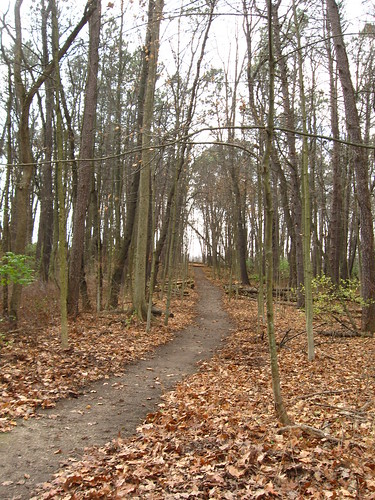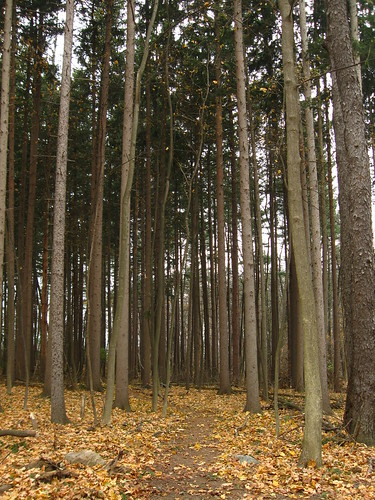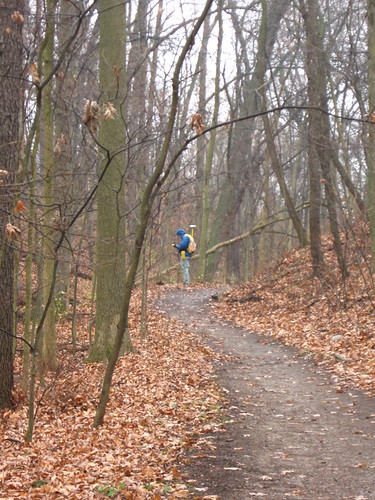As you walk around Saginaw Forest - or actually any area with trees - you might not have wondered where the trees actually came from. I mean, it was probably never a question that you asked. But do you really know where all that "stuff" that makes the tree actually came from?
Before you check out this video from Veritasium, stop for a moment and make a prediction.
Got it?
Okay, now click, "PLAY":
For all of you who don't have a background in biology, was your prediction correct?
So now that you know where all the mass of a tree comes from, you might have an additional appreciation for why forests (and also deforestation) is important when thinking about the future.
Use of the Forest
Public use of Saginaw Forest is encouraged. Rules for the public's use include (but are not limited to):
- No parking in front of the access gate.
- Public use hours are from 6am to 6pm only; no camping on the site!
- No vehicles or bicycles are permitted on the site except those for approved research and teaching use (bike parking available at the main gate).
- Dogs with owners are welcome to visit, but they must be on a leash. (Also see here.)
- Dog owners must carry out all pet waste; please bring your own doggie bag to do so.
- No cutting or collecting of plant material; no hunting or harming vertebrates (this includes no fishing).
- No smoking.
Monday, December 17, 2012
Saturday, December 15, 2012
Raking the trails
Much of the trails in Saginaw Forest have been raked - by yours truly.


Why did I do all of this? After all, next year, it will all get covered again, right?
Well, each of the last few years, I've had to negotiate walking along the pathways in the springtime, with them in a treacherous semi-frozen, semi-slushed, semi-muddy mess. Over the year, the walking of the trails crushes the leaves, breaking them down. And then, when the snows come, the ground (and leaves and mashed leaves) gets saturated. When this starts to thaw, the leaves produce discontinuous layers of ice, frozen leaves, water, slosh, wet leaves, etc. In other words: a mess.
The idea is that - since most of the soil of the property is sand, and the majority of the paths are gravel laid atop this sand - if I rake the leaves, there will be greater amounts of infiltration in the spring. Furthermore, even in places where the leaf litter buildup and decomposition have accumulated a significant enough layer of soil, raking away the leaves will allow for this soil to be more easily washed away, revealing the gravel path below (thus improving the quality of the pathways - as pathways).
I even raked a trail out to Westview Way, so that it will be easy to stay off the untrodden ground (we don't like unnecessary soil compaction) while walking into the facility:


Why did I do all of this? After all, next year, it will all get covered again, right?
Well, each of the last few years, I've had to negotiate walking along the pathways in the springtime, with them in a treacherous semi-frozen, semi-slushed, semi-muddy mess. Over the year, the walking of the trails crushes the leaves, breaking them down. And then, when the snows come, the ground (and leaves and mashed leaves) gets saturated. When this starts to thaw, the leaves produce discontinuous layers of ice, frozen leaves, water, slosh, wet leaves, etc. In other words: a mess.
The idea is that - since most of the soil of the property is sand, and the majority of the paths are gravel laid atop this sand - if I rake the leaves, there will be greater amounts of infiltration in the spring. Furthermore, even in places where the leaf litter buildup and decomposition have accumulated a significant enough layer of soil, raking away the leaves will allow for this soil to be more easily washed away, revealing the gravel path below (thus improving the quality of the pathways - as pathways).
I even raked a trail out to Westview Way, so that it will be easy to stay off the untrodden ground (we don't like unnecessary soil compaction) while walking into the facility:
Friday, December 14, 2012
Surveying the creek
Saturday, December 8, 2012
They aren't the oldest trees in the world, but...
In reading through my news items for today, I came across an article describing the fragility old trees in a changing climate:
Still, it's something to think about when you're walking through the forest, recalling (in some deep recess of your mind) that you are walking through a forested landscape that - while not a "natural" forest - is in the range of 60-100+ years old. It's still a relatively "new" forest in that way, having not "matured" to be dominated by the climax community that we would have experienced way back in the early 1800s: a hardwood forest of oak, maple, and beech. It may also be sobering to recall that - thanks to climate change and the changed driving forces that our new and future climate have on the local ecology - Saginaw Forest will not be changing to resemble that 1800s forest of Southeast Michigan so much as a forest that would have been more typical of central Ohio.
In sum - and to bring it back to the topic of the paper - the century-plus old trees on the northern side of the property will likely die faster now than they would have if the climate hadn't changed, that those trees will also be more quickly releasing their stored carbon into the atmosphere, and that those reaches of the property are on a destined path toward a climax forest that would have been more recognizable around the Columbus, OH of 1800 than the Ann Arbor, MI of that same time.
A report by three of the world's leading ecologists in today's issue of the journal Science warns of an alarming increase in deathrates among trees 100-300 years old in many of the world's forests, woodlands, savannahs, farming areas and even in cities.The reason behind this increased rate of die-off among old trees? Well, it's not only because the trees are reaching the end of their lives (some trees can live for several centuries, after all), but because the environments in which these trees live are changing. And why is this happening? Well:
"According to one popular theory, trees get a double-whammy when the thermometer rises. "During the day, their photosynthesis shuts down when it gets too warm, and at night they use more energy because their metabolic rate increases, much as a reptile's would do when it gets warmer." With less energy being produced in warmer years and more being consumed just to survive, there is less energy available for growth. "This hypothesis, if correct, means tropical forests could shrink over time," Professor Laurance said. "The largest, oldest trees would progressively die off and tend not to be replaced. Alarmingly, this might trigger a positive feedback that could destabilize the climate: as older trees die, forests would release some of their stored carbon into the atmosphere, prompting a vicious circle of further warming, forest shrinkage and carbon emissions."In Saginaw Forest, we don't think of the trees as being particularly "old" - at least I doubt that many people think of Saginaw Forest as some sort of primeval wood, but it's important to remember that some of the trees on the property have joined the century club, having been planted waaay back in 1904. And these trees are dying off, although whether it's due to being planted too close or due to physiological exacerbations caused by climate stress (since many of these old Saginaw Forest trees are actually native to more northerly regions of the state), I can't say.
Still, it's something to think about when you're walking through the forest, recalling (in some deep recess of your mind) that you are walking through a forested landscape that - while not a "natural" forest - is in the range of 60-100+ years old. It's still a relatively "new" forest in that way, having not "matured" to be dominated by the climax community that we would have experienced way back in the early 1800s: a hardwood forest of oak, maple, and beech. It may also be sobering to recall that - thanks to climate change and the changed driving forces that our new and future climate have on the local ecology - Saginaw Forest will not be changing to resemble that 1800s forest of Southeast Michigan so much as a forest that would have been more typical of central Ohio.
In sum - and to bring it back to the topic of the paper - the century-plus old trees on the northern side of the property will likely die faster now than they would have if the climate hadn't changed, that those trees will also be more quickly releasing their stored carbon into the atmosphere, and that those reaches of the property are on a destined path toward a climax forest that would have been more recognizable around the Columbus, OH of 1800 than the Ann Arbor, MI of that same time.
Subscribe to:
Posts (Atom)
